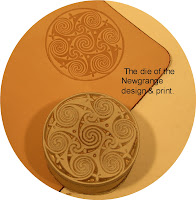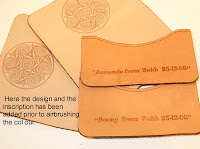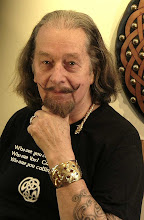
Greetings Celts,
It has been awhile since last I blogged, although there was no Celtic Fest in 2010, I was still up to my ears in work. In time for this year's Celtic Fest I was at last able to get the work on a torque done. This has not yet been put onto my website, but that will be the next step.  The torque measures 5.5" or 14cm across and 7" or 18cm top to the opening. It is made from brass and can be adjusted by shaping it to your own size. I shall be offering a choice of the plain torque or you can have it gold plated to avoid tarnishing. The boar's head has ruby red crystal eyes but no tusks, I intend to offer them with bone, ivory or mastadon ivory tusks. Although they are quite small, it is very time consuming to make them. Anyone wishing to make their own is welcome to do so. I can willingly supply the material for you to do your own.
The torque measures 5.5" or 14cm across and 7" or 18cm top to the opening. It is made from brass and can be adjusted by shaping it to your own size. I shall be offering a choice of the plain torque or you can have it gold plated to avoid tarnishing. The boar's head has ruby red crystal eyes but no tusks, I intend to offer them with bone, ivory or mastadon ivory tusks. Although they are quite small, it is very time consuming to make them. Anyone wishing to make their own is welcome to do so. I can willingly supply the material for you to do your own.
 The torque measures 5.5" or 14cm across and 7" or 18cm top to the opening. It is made from brass and can be adjusted by shaping it to your own size. I shall be offering a choice of the plain torque or you can have it gold plated to avoid tarnishing. The boar's head has ruby red crystal eyes but no tusks, I intend to offer them with bone, ivory or mastadon ivory tusks. Although they are quite small, it is very time consuming to make them. Anyone wishing to make their own is welcome to do so. I can willingly supply the material for you to do your own.
The torque measures 5.5" or 14cm across and 7" or 18cm top to the opening. It is made from brass and can be adjusted by shaping it to your own size. I shall be offering a choice of the plain torque or you can have it gold plated to avoid tarnishing. The boar's head has ruby red crystal eyes but no tusks, I intend to offer them with bone, ivory or mastadon ivory tusks. Although they are quite small, it is very time consuming to make them. Anyone wishing to make their own is welcome to do so. I can willingly supply the material for you to do your own. 



















